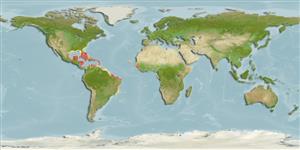Environment: milieu / climate zone / depth range / distribution range
Ekologi
marina revassocierade; djupintervall 0 - 40 m (Ref. 13121), usually 0 - 3 m (Ref. 9710). Subtropical; 32°N - 26°S, 100°W - 32°W
Southwestern Atlantic: from Bahamas and Florida southwards to Brazil.
Size / Vikt / Age
Maturity: Lm ? range ? - ? cm
Max length : 7.5 cm TL hane/ej könsbestämd; (Ref. 13628)
Short description
Morfologi | Morfometri
Taggstrålar i ryggfenan (totalt): 20 - 21; Mjukstrålar i ryggfenan (totalt): 11-12; Taggstrålar i analfenan 2; Mjukstrålar i analfenan: 20 - 22. With 3-5 dark brownish-red bands in form of inverted triangles along side. No other labrisomid has this distinctive color pattern (Ref. 26938). Head with a few small dark spots; bars on body sometimes not very dark but outlined by dark bars; scattered dots then often present elsewhere on the body (Ref. 13442).
Inhabits coral reefs and rocky shores. Often found in crevices, or among weed and rubble (Ref. 13121). Feeds on crustaceans (Ref. 13628).
Life cycle and mating behavior
Könsmognad | Reproduktion | Lek | Ägg | Fecundity | Larver
Robins, C.R. and G.C. Ray, 1986. A field guide to Atlantic coast fishes of North America. Houghton Mifflin Company, Boston, U.S.A. 354 p. (Ref. 7251)
IUCN Red List Status (Ref. 130435)
Threat to humans
Harmless
Human uses
Akvarium: Kommersiell
Ytterligare information
PopulärnamnsynonymerMetabolikPredatorerEkotoxikologiReproduktionKönsmognadLekSpawning aggregationFecundityÄggEgg development
referenserVattenbrukVattenbruksprofilAvelslinjerGenetikElectrophoresesÄrftlighetSjukdomarBehandlingNutrientsMass conversion
MedarbetareBilderStamps, Coins Misc.LjudCiguateraHastighetSimsättGälytaOtolithsHjärnstorlekSyn
Verktyg
Special reports
Download XML
Internet-källor
Estimates based on models
Preferred temperature (Ref.
123201): 26.3 - 28.2, mean 27.5 °C (based on 645 cells).
Phylogenetic diversity index (Ref.
82804): PD
50 = 0.5000 [Uniqueness, from 0.5 = low to 2.0 = high].
Bayesian length-weight: a=0.00912 (0.00399 - 0.02083), b=3.06 (2.87 - 3.25), in cm total length, based on LWR estimates for this (Sub)family-body shape (Ref.
93245).
Trofisk nivå (Ref.
69278): 3.5 ±0.50 se; based on food items.
Fishing Vulnerability (Ref.
59153): Low vulnerability (10 of 100).
Nutrients (Ref.
124155): Calcium = 75.4 [33.0, 164.9] mg/100g; Iron = 0.804 [0.436, 1.431] mg/100g; Protein = 19.4 [18.3, 20.5] %; Omega3 = 0.263 [0.143, 0.481] g/100g; Selenium = 10.5 [4.3, 22.4] μg/100g; VitaminA = 124 [37, 429] μg/100g; Zinc = 1.45 [0.88, 2.25] mg/100g (wet weight);
